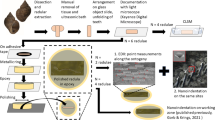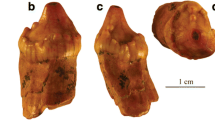Summary
The surface of selachian teeth is covered by a 0.2–0.9 mm layer which is analogous to the enamel in mammals. The first detailed study on this material with the aid of a scanning electron microscope was made by Reif (1973b).
The mechanical resistance of this tissue is greater than that of dentine. Various forms of “enamel-like tissue” do occur. They obviously are correlated with the shape of a tooth and the stresses to which it may be subject: The “single-crystallite enamel” covers the crushing teeth, it is apparently resistant against compressive stresses. The “parallel-fibred enamel” of fangs and cutting teeth is resistant to tensile stresses. Underneath it, there is a “fibrous enamel”, the fibres of which are randomly orientated in space. This tissue seems to be resistant against compression. Fangs as well as cutting teeth are covered by a “shiny layer” which excludes the occurrence of fissures in the “parallel fibred enamel”.
The “single-crystallite enamel”-caps on crushing teeth can be considered as “shell-constructions” in a mechanical sence. Their resistance often is increased by a surface relief. The distribution of stresses within the “shell” and the structure of the “enamel” are discussed in detail. The shapes of the elements seem to be optimally adapted to the stresses that may occur.
Fangs and cutting teeth are in a mechanical sence triangular consoles. The calculation of the stresses which occur under a number of external forces shows that the real shapes are normally bodies of uniform strength against accurately defined loads.
The points or areas of application as well as the directions of the latter correspond to special shapes. In view of the few informations available about biting behaviour in sharks, the considered loads seem to be quite reasonable representations of the forces to which a shark's teeth are exposed.
The positions and orientation of the enamel-fibres on fangs and cutting teeth are in perfect accordance with the pattern of trajectories in a homogeneous tooth model under stresses equal to those evoked by the above-mentioned loads.
The fibre pattern is the clearer developed, the greater the stresses at a special point are.
Some particular trajectorial patterns, which would appear under certain conditions, are not realised as far as we know today. We assume, that these theoretically possible variations of loading do not occur in the investigated forms, because the animals do not bite this way.
According to our observations, in teeth as well as in primitive vertebrates, the same close relationship between shape and function seems to exist, as has been found repeatedly in the postcranial skeleton of mammals. In view of the way of exchange of shark teeth it can only be a case of “preadaptation”.
Zusammenfassung
An der Oberfläche von Selachierzähnen befindet sich eine dem Schmelz der Säugetiere analoge Schicht, die von Reif erstmals eingehend elektronen-rastermikroskopisch untersucht worden ist. Die mechanische Widerstandsfähigkeit dieser 0,2–0,9 mm dicken Schicht ist größer als diejenige des Dentins.
Je nach der Gestalt und der dadurch bestimmten Beanspruchung der Zähne sind verschiedene Formen von “Schmelz” ausgebildet: der allem Anschein nach sehr druckfeste “Einzelkristallitschmelz” der Quetschzähne und der zugfeste “parallelfaserige Schmelz” der Fang- und Schneidezähne. Vielfach kommt daneben noch ein “wirrfaseriger Schmelz” vor, der unter Umständen Zugspannungen aufzunehmen scheint. Fang- und Schneidezähne sind von einer sehr dünnen “Glanzschicht” bedeckt, welche Rißbildung verhindert.
Die aus “Einzelkristalliten” aufgebauten Schmelzkappen der Quetschzähne können als flächig unterstützte Schalentragwerke im mechanischen Sinne interpretiert werden. Ihre Festigkeit wird oft durch ein Oberflächenrelief erhöht. Die Lastabtragung innerhalb der Schale und die Feinstruktur des “Schmelzes” werden im Detail diskutiert. Die Gestalt der Elemente scheint jeweils an die mechanische Beanspruchung optimal angepaßt zu sein.
Die Fang- und Schneidezähne stellen im mechanischen Sinne dreieckige Konsolen dar. Eine Berechnung der Spannungen in derartigen Konsolen zeigt, daß die tatsächlich vorgefundenen Formen in der Regel “Körper gleicher Festigkeit” gegenüber genau definierbaren Beanspruchungen darstellen. Diese Beanspruchungen sind oft einfache Kombinationen aus Flächen- bzw. Punktlasten. Diese Last-Kombinationen erscheinen vom biologischen Standpunkt aus, bei Berücksichtigung des Wenigen, was wir über das Verhalten von Haien wissen, sinnvoll und wahrscheinlich.
Die Anordnung der “Schmelzfasern” an der Oberfläche von Fang- oder Schneidezähnen entspricht dem Verlauf von Spannungs-Trajektorien in einem homogenen Zahnmodell unter Beanspruchungen, wie sie von den obengenannten Lasten hervorgerufen werden. Die Fasermuster sind um so deutlicher ausgeprägt, je höher die Spannungen im jeweiligen Teil des Zahnes sind.
Manche der bei bestimmten Belastungen zu erwartenden Trajektorienmuster sind in Haifischzähnen nach unseren bisherigen Kenntnissen nicht in Form von Fasermustern realisiert. Es wird unterstellt, daß diese theoretisch möglichen Belastungen bei den untersuchten Tieren während des Lebens nicht auftreten.
Aus den Befunden wird gefolgert, daß hier, d.h. auch bei Zähnen und auch bei primitiven Vertebraten der gleiche enge Zusammenhang zwischen Form und Funktion besteht, wie er am postcranialen Skelet von Säugetieren mehrfach nachgewiesen worden its. Es kann sich angesichts der Funktionsweise von Haifischzähnen nur um eine “Präadaptation” handeln.
Similar content being viewed by others
Literatur
Haller, Graf: Über die Entwicklung, den Bau und die Mechanik des Kieferapparates des Dornhais (Acanthias vulgaris). Morph. Jb. 2 Abt., 749–793 (1926)
Kemp, N. E., Park, J. H.: Fine structure of enanel and collagen in the crown of mineralizing teeth of the shark Carcharhinus menisorrah. Anat. Rec. 163, 210 (1969)
Kummer, B.: Bauprinzipien des Säugerskelets. Stuttgart: Thieme 1959a
Kummer, B.: Biomechanik des Säugetierskelets. In: Helmcke, Lengerken u. Starck, Handbuch der Zoologie, Bd. 8, 6, Lfg. 24. Berlin: De Gruyter 1959b
Kummer, B.: Photoelastic studies on the functional structure of bone. Folia biotheoretica 6, 31–40 (1966)
Kuske, A.: Einführung in die Spannungsoptik. Stuttgart: Wissenschaftl. Verlagsgesellschaft 1959
Ørvig, T.: Phylogeny of tooth tissues: Evolution of some classified tissues in early vertebrates. In: Structural and chemical organization of teeth (A. E. W. Miles, ed.), vol. I, p. 45–111. New York & London: Academic Press 1967
Preuschoft, H.: Statische Untersuchungen an den Füßen der Primaten, Teil I: Statik der Zehen und des Mittelfußes. Z. Anat. Entwickl.-Gesch. 129, 285–345 (1969)
Preuschoft, H.: Functional anatomy of the upper extremity. In: Bourne (ed.), The chimpanzee, vol. 6, p. 34–120. Basel-New York: Karger 1973
Reif, W.-E.: Morphologie und Skulptur der Haifisch-Zahnkronen. N. Jb. Geol. Paläont., Abh. 143, 39–55 (1973a)
Reif, W.-E.: Morphologie und Ultrastruktur des Hai-“Schmelzes”. Zoologica Scripta 2, 231–250 (1973b)
Schaeffer, B.: Comments on Elasmobranch evolution. In: Sharks, skates and rays (Gilbert, Mathewson and Rall, ed.), p. 3–36. Baltimore: Johns Hopkins Press 1967
Snodgrass, I. M., Gilbert, P. W.: A sharke-bite meter. In: Sharks, skates and rays, (Gilbert, Mathewson and Rall ed.), p. 331–340, Baltimore: Johns Hopkins Press 1967
Author information
Authors and Affiliations
Additional information
Unterstützt durch den SFB 53 “Palökologie”, Tübingen. Publikations-Nummer: Konstruktions-Morphologie 16 (Nr. 15 ist erschienen in “Human Evolution”, Editor M. H. Day, Taylor & Francis, London 1973).
Rights and permissions
About this article
Cite this article
Preuschoft, H., Reif, WE. & Müller, W.H. Funktionsanpassungen in Form und Struktur an Haifischzähnen. Z. Anat. Entwickl. Gesch. 143, 315–344 (1974). https://doi.org/10.1007/BF00519872
Received:
Issue Date:
DOI: https://doi.org/10.1007/BF00519872




